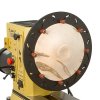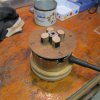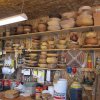For tightening the bumpers equally, I've found it beneficial to tighten diametrically opposite bumpers in sequential pairs, vs. tightening in circular fashion; similar to the proper way of attaching car wheels. Probably good practice with Jumbo jaws too.
I haven't found connection to the scroll chuck troublesome. The same jaws hold a spigot for inside work. With your Jumbo jaws, don't you need to swap jaws?
Regardless of the mounting method, perfectly concentric seems like a futile pursuit, and relies on a perfectly round rim. I try to place the foot ring inboard about 1/8" with a step about 1mm deep, for a floating appearance. Sometimes it's perfectly concentric, sometimes it isn't.
Hello Joe.......
Unlike the Longworth method of holding the bowl, the rubber grippers on the Jumbo Jaws do not compress with the amount of tightness of the mount screw, like the Longworth rubber grippers do. They are made with a metal center, sort of like a tire on a rim. Because of this, they do have an advantage where concentricity is a concern.
For my turnings, concentricity is a concern. Since the actual width of the foot is often very narrow and delicate, a small discrepancy is more noticeable. This is why concentricity is an issue for me, whereas it might not be as much so with some other turners. To my way of seeing this, I am ahead of the game by choosing the re-chuck method with the greatest amount of precision from the git-go, rather than to rely on adapting to a holding method that is less so.
The Jumbo Jaws rely on the chuck slides for it's holding ability, rather than compressing eight rubber grippers with equality, as is the case with the Longworth chuck.
Yes, the Jumbo plates, and the Mega Jumbo plates will now have to be swapped out, as the need dictates. The Mega Jumbo plates will now only be needed for my largest turnings. I have three Oneway Stronghold chucks, and one of these was dedicated to the Mega Jumbo plates, but now will be dedicated to two sets of Jumbo plates. Another Stronghold chuck is dedicated to No. 2 jaws and is used for probably 75 percent of all my bowls. The third Oneway Stronghold chuck is the one I use to switch out jaws for all other applications. Originally, I was interested in the Longworth chuck strictly because it would have been easily used with the No. 2 jaws in the dedicated chuck, but the concentricity issues made me change my mind about how well the Longworth chuck is adaptable to my style of turning.
As for concentricity being a futile pursuit, I'd have to agree that perfect precision isn't possible.......but, some methods are distinctly better at achieving concentricity than others.
All these things mentioned here, and in previous posts, are why I made the decision I did....... Of course, this does not mean that what is important to me, is, or should be the concern of other turners, but my decisions are based on my needs.......not an average of all turners as a whole!

......good turning to you all!........:cool2:
ooc
.
It will be nice to not have to keep wrapping the buttons in tape to keep the black marks off my work. That always bugged me about the Oneway jumbo jaws.
Ed
Ed.......I've never had a need to wrap the rubber grippers on the Mega Jumbo jaws, and have never had any black marks. I'm not sure what it is that you are doing differently than I am, but obviously there is something that is different. For your needs, the Longworth chuck may be the best method for you......
I hope that what I've expressed in this thread isn't construed as meaning either the Longworth, or the Oneway Jumbo jaws is/are better solutions for all turners, but those things that separate us as individual turners do mean that what, and how we choose our methods are definitely individual considerations.
ooc
.







